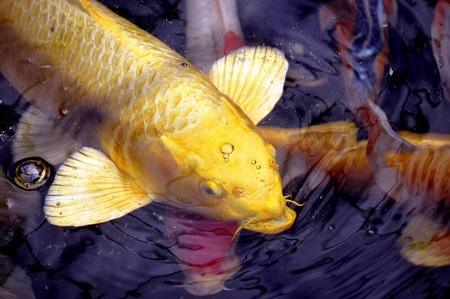Koi Fish Facts
Factors Influencing Koi Fish Metabolism and Diet
Your koi fish like to eat. And they can do so quite regularly given the right conditions. As natural foragers worried about where their next meal will come from, they will eat almost anything their taste buds and barbels tell them is worth eating. Plants, algae and insects are a few of their dietary staples when not in a pond.
It doesn’t mean, however, that you as their keeper are off the hook. The environment you have created means that they won’t have access to the same conditions they will find in their natural settings.
If you are looking to get your koi to their optimum size and condition, you have to supplement their diet. There are a number of factors that contribute to your koi’s metabolic rate (and as such their appetite) as well as what types of food they will need to grow, thrive and remain healthy.
Genetics
Some varieties of koi are naturally more inclined to be quicker to the feeding trough than others. Both the Chagoi and Soragoi in the Kawarimono class are known as larger varieties and as such usually have bigger requirements and aren’t shy of a meal when it is on offer.
Age
As a general rule, the younger your koi is, the higher its growth rate is and as a result the more robust its appetite will be. A koi’s age will inform the amount of protein (as a percentage of daily requirements) that it will need.
Generally, and we say this because situations and conditions will dictate what the needs are, at spring and early summer temperatures (60-75ºF) one-year-old koi require their daily intake to be comprised of 40-45% protein, two-year-old koi 30-40% and three-year-old and up koi are at 25-30%.
Water temperature
As cold-blooded creatures, a koi’s metabolic rate is very much dictated by the surrounding water temperature. Warmer weather usually means warmer water, which ordinarily translates to hungrier koi in the spring and summer.
Koi also do their growing in these months and as such will need a higher food intake to accommodate it.
Koi are particularly hardy and can survive harsh winters with their metabolism in a form of stasis where the stored fats provide the necessary calories for survival so no food intake is necessary. In fact, it can result in harm if they are overfed when their metabolism is inactive.
A good rule of thumb to remember is that every 18ºF shift in temperature will double a koi’s metabolic rate. So if you start at around freezing (+/- 34ºF) with a rate of 1, at 52ºF it will be at 2, at 70ºF will be 4 and at 88ºF is at an 8.
Water temperature also determines the type of food they should receive. As the koi’s growth slows, so does the need for protein, which means at lower temperatures you can use lower amounts of protein (around 25% at sub-60ºF).
Water quality
More waste in a pond will mean less oxygen in the water and less vitality as a result. Fresh water can be an appetite booster for your koi fish. Rain will add a new vitality to the water by stirring up silt (and the nutrients in it) as well as bump up the oxygen content. Adding fresh water will simulate that natural reaction in your koi and cause an upswing in their eating habits.
Health
Sick koi are usually not hungry koi. If your koi is sick (or recovering from an illness) they won’t process or digest higher protein diets quite as well, so something lower in protein is a good idea.
Gender
Females will require more to eat than males as their nutrients are passed along to eggs during spawning season. This can also affect their color. Color-enhancing mixes can be helpful in getting the females back to their brightest.
At Next Day Koi, our koi fish for sale are sourced from some of the biggest and most reputable suppliers in the industry. All of our fish are quarantined in separate holding facilitates and during the minimum 2 week quarantine period fish are monitored for any signs of health issues.
We also offer a 14 Day Worry Free Guarantee. Additionally, if you have questions or concerns about the health of your koi, please contact us and we will be happy to help you.




